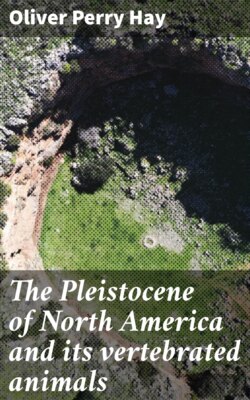Читать книгу The Pleistocene of North America and its vertebrated animals - Oliver Perry Hay - Страница 58
CONNECTICUT.
Оглавление(Maps 5, 6.)
1. Cheshire, New Haven County.—In 1828 (Amer. Jour. Sci., vol. XIV, p. 187), a note appeared which stated that in the summer of the preceding year 3 or 4 large molar teeth of a “mammoth” had been found near Cheshire. From the description it is evident that they were teeth of a mastodon. They were in fine condition but were immediately destroyed in a frolic of the workmen. The teeth had been found in gravel only a few feet under ground. Warren (“Monogr. on Mastodon giganteus,” p. 3) stated that the mastodon teeth had been found in making a canal at Cheshire. He undoubtedly referred to the teeth mentioned above. Schuchert (Amer. Jour. Sci., ser. 4, vol. XIV, p. 321) states that one tooth was preserved and is now in the Yale University collection.
2. New Britain, Hartford County.—In 1835 (Amer. Jour. Sci., vol. XXVII, p. 165), a report was published about the finding of a vertebra of a mastodon in digging a canal for a factory in Berlin, not far from New Britain. It appears to have been met with in a deposit of marl. Schuchert (op. cit., p. 322) mentions this find and says that the locality was not in Berlin, but in New Britain. The depth is given as 3 feet and the material as mud or clay.
Schuchert, as cited, gave an account of the discovery, in 1852, of another mastodon in New Britain. Two or three teeth and some bones were found in a soft swampy soil.
3. Farmington, Hartford County.—In 1914 (Amer. Jour. Sci., vol. XXXVII, pp. 321–330), Schuchert and Lull described the exhumation of a mastodon near the town named. All of the principal bones of the skeleton were secured. One tusk and most of the foot-bones were missing. The account ought to be taken by collectors as a model for their reports. The exact position of the skeleton is given. A topographic map of the surrounding region is furnished, as well as the details concerning the materials occurring above and below the bones. These lay on boulder clay of Wisconsin age and were covered by materials washed in from the surrounding higher grounds. No mollusks were found in the excavation, and little vegetation. The bones, as shown by Lull’s map, were remarkably little disturbed, not more than one might expect from the activities of wolves. One of the tusks was, however, removed from the skull a distance of 23 feet and left on ground 2 feet higher. Schuchert regarded this as being hard to explain. The other tusk was not found at all.
4. Bristol, Hartford County.—In 1885 (Trans. N. Y. Acad. Sci., vol. V, p. 14), O. P. Hubbard stated that the remains of a mastodon had been found at Bristol, but no further information was furnished.
5. Sharon, Litchfield County.—In 1828 (Amer. Jour. Sci., vol. XIV, p. 187), in a footnote, it was reported that, a good many years before that time, some remains of mastodon had been found near Sharon. In 1835 (ibid., vol. XXVII, p. 166) it was stated that a mastodon bone, found probably at Sharon, had been presented to the museum of Yale College. There seems to be no certainty that the bone was correctly identified.
